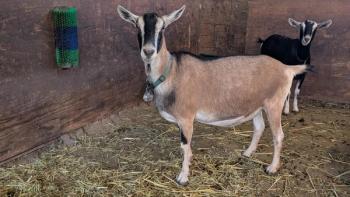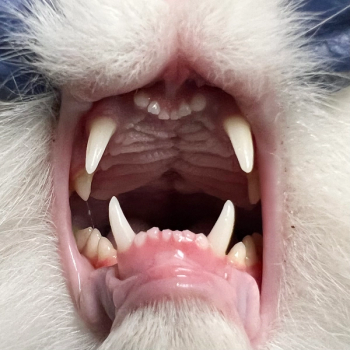
- dvm360 April 2019
- Volume 50
- Issue 4
Study finds new supplement supports muscle mass retention and earlier return to normal weight-bearing post-TPLO surgery
The compound, derived from fertilized egg yolk, was studied in a randomized, double-blinded, placebo-controlled study at Kansas State Universitys College of Veterinary Medicine.
A new supplement showed positive results for dogs with naturally occurring cranial cruciate ligament (CCL) rupture recovering from tibial plateau leveling osteotomy (TPLO) in a study conducted at Kansas State University's College of Veterinary Medicine. After undergoing a TPLO, veterinary patients often show marked muscle loss in the affected limb due to disuse atrophy. This study evaluated the impact of Fortetropin on attenuating muscle atrophy after TPLO surgery.
Principal study investigator Kenneth R. Harkin, DVM, DACVIM (SAIM), presented the study results on Jan. 20 in the Discovery Theater at the 2019 VMX conference in Orlando, Florida. His presentation “The impact of Fortetropin supplementation on dogs recovering from TPLO surgery” was sponsored by the product manufacturer, MYOS RENS Technology, a biotherapeutics and bionutrition company. The company also fully funded the study.
Dr. Harkin's presentation highlights and the study's key findings include:
One of the dvm360 team participated in this study!
Associate Content Specialist Katie James' dog Blitz tore his right CCL in March 2018 and had a TPLO repair performed at K-State. They participated in this study as mentioned in this article about the postsurgical recovery process.
> This randomized, double-blinded, placebo-controlled study involved 100 dogs. As a model for recovery from surgery, TPLO was selected because of reproducibility.
> Fortetropin is a nonthermal pasteurized, freeze-dried fertilized egg yolk product. Fertilized egg yolk exhibits a proteomic profile that differs in 18 proteins compared with unfertilized egg yolk.
> Dogs in the Fortetropin and placebo (cheese powder protein) groups were evaluated at baseline and postoperatively at eight and 12 weeks. The dogs had eight weeks of forced exercise restriction postoperatively, with a gradual return to activity during weeks nine through 12.
> The study participant evaluations included thigh circumference measurement, stance force analysis, serum myostatin and C-reactive protein concentration measurements, ultrasonographic assessments of thigh and epaxial muscle thickness, and muscle condition scoring.
> Dogs in the Fortetropin group showed no change in thigh circumference, which was statistically significant at the p < 0.1 level. This indicated that dogs receiving Fortetropin did not exhibit disuse muscle atrophy compared with the placebo group.
> Force plate stance analysis showed that Fortetropin-supplemented dogs had more significant improvement in percentage of weight supported by the affected limb (faster return to normal stance distribution) than did dogs in the placebo group.
> Myostatin is a protein that prevents muscle growth and promotes muscle atrophy. Dogs that received Fortetropin showed no significant change in serum myostatin concentrations over any time period, which indicated that myostatin was inhibited in this group compared with the placebo group. Significant changes in myostatin concentrations were noted in the placebo group, indicating that myostatin was not inhibited in these dogs. The mechanism of action of fertilized egg yolk in reducing serum myostatin concentrations is unknown.
> The study results also showed that C-reactive protein, a biomarker of inflammation, was not elevated in either group. Muscle condition scores were not significantly different between the two groups. Furthermore, the results indicated that ultrasonographic evaluation of muscle thickness may have been a suboptimal assessment because of interobserver variability and because the same ultrasonographer did not perform all evaluations.
In the MYOS RENS Technology press release, Dr. Harkin says, "This study demonstrates the benefits of Fortetropin in dogs with prolonged postoperative recovery periods. Restoration or maintenance of muscle mass through the reduction of serum myostatin levels with Fortetropin offers veterinarians a novel approach to in-home rehabilitation of injured dogs, including potentially improving or restoring mobility in geriatric dogs."
The company also states in their release that they believe the results of the study will enable them to expand their veterinary business and change how veterinary teams address canine muscle health. It also plans to pursue clinical trials for human rehabilitation and recovery applications.
Articles in this issue
over 6 years ago
Commentary: Alvins trip to the veterinarianover 6 years ago
New initiative aims to spread heartworm awareness, actionover 6 years ago
The future of veterinary medicineover 6 years ago
Laser therapy dosing explainedover 6 years ago
Can't we just sit tight sometimes?over 6 years ago
dvm360 Hospital Design Competition announces 2019 winnersover 6 years ago
Reexamining the early spay-neuter paradigm in dogsover 6 years ago
Dangerous new tick species migrating to North Americaover 6 years ago
Petplan gives North American awards at VMXNewsletter
From exam room tips to practice management insights, get trusted veterinary news delivered straight to your inbox—subscribe to dvm360.






